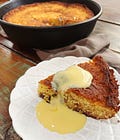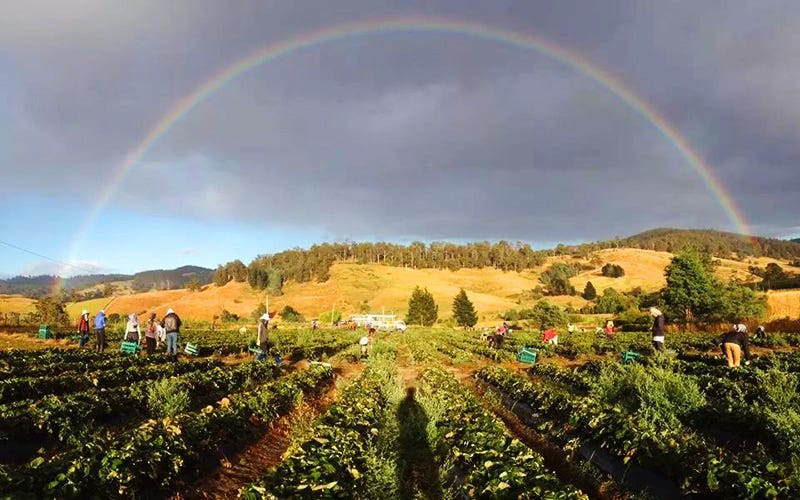Strawberries are invariably the first fruit of spring. They’re a welcome sight after the long months of citrus, apples and pears, and while I enjoy all of those, I start to long for the variety available in the warmer months. Locally, strawberries are grown in commercial quantities in Cygnet, just over the river from us and with their temperatures just a couple of degrees warmer than here, makes large-scale strawberry growing more viable. DM Jennings and Sons started growing strawberries in 1983, and today, they are the largest commercial strawberry farm in Tasmania. Even so, in the scheme of commercial berry growing, this is a small farm, still subject to the vagaries of the weather rather than being protected by enormous polytunnels and manmade weather that you might find elsewhere.
Like all of the locally grown crops, there is an annual rhythm to the preparation, planting, growing and harvesting. It is one of the joys of living in a rural area, to see first-hand what goes into food production, and it certainly makes you appreciate the effort required to grow the food we take for granted.
The strawberry beds are prepared during winter with the construction of mounded plastic covered rows. Driving past the farm regularly, the changes from a distance are initially minimal until suddenly, the bare ground is covered in greenery, and you know that strawberries aren’t far away. Days before the harvest begins, the port-a-loos are moved onto the site, the buckets for holding the ripe strawberries are stacked up, and then one day, the fields are a flurry of activity.
I picked strawberries once, for a whole day. I was home from university, looking for holiday work, and there were strawberry farms not far from us. I thought, very naively, that it might be a good way to make a bit of money, improve my fitness, and spend some time outside. I didn’t expect that I would be great to start with, but I figured with practice, I could make a go of it. How wrong I was! It is backbreaking work. Strawberry plants are low to the ground, constant bending is required, and it takes forever to fill a container. Needless to say, I made almost no money, was sunburnt, could barely move the following day and decided that a career picking fruit was not for me.
It only took that one day for me to appreciate what difficult work fruit picking is, and I‘m in awe of the fruit-picking workforce for their physical stamina and ability to harvest enough to earn a decent wage. It also gave me a much greater appreciation of what‘s required to get food into the shops and people’s homes. Sure, there are huge producers with mechanical means of planting and harvesting, but there is still an awful lot that is undertaken by skilled workers. Many of them are from overseas, foreign residents who have left their families to fill a gap created by a local labour force disinterested in picking fruit. For months, they make their home at the local backpackers, spending their days picking fruit, moving from one crop to the next as the season progresses. I’m very grateful, and it certainly makes me think twice before complaining about the cost of food.
This cake is one of my kitchen workhorses. Its simplicity is elevated by the addition of fruit, which is infinitely variable. Sometimes, I make it in a skillet, taking it to the table to serve with ice cream or custard as a simple dessert. Other times, I make it in a round cake tin and serve a wedge with a dollop of cream for afternoon tea. I also make it in a loaf tin and cut a slice for a late morning pick-me-up. Sometimes, the fruit almost completely disappears into the batter and other times, it marbles on the top. It is the little black dress of cakes.
In this version, I’ve gone with strawberries roasted with pepperberry. Pepperberry is a native Tasmanian plant that thrives locally. Just down the road from us is a small pepperberry orchard, the shrubs growing on the flood plain of the Kermandie River. They thrive in the cool and wet. Both the leaves and berries are edible, and the peppery heat is combined with a herbal flavour. It is readily available to buy online, but you can substitute an equivalent amount of freshly ground black pepper.
Pepperberry Roasted Strawberry Cake
Makes 1 x 23 cm cake. Serves 8.
For the strawberries:
500 g fresh strawberries, hulled and halved or quartered depending on size
2 tablespoons olive oil
40 g caster sugar
1 teaspoon ground pepperberry, or black pepper
For the cake:
170 g plain flour
1 teaspoon baking powder
115 g salted butter
200 g caster sugar
1 teaspoon vanilla paste
2 eggs
120 ml buttermilk
Preheat the oven to 170°C. Grease a 23 cm skillet, or grease and line the equivalent sized cake tin with baking paper.
Put the strawberries into a roasting tin. Drizzle over the olive oil and add the sugar and pepperberry. Toss them gently and roast for about 15-20 minutes, or until they are collapsed and soft. Allow them to cool.
To make the cake, put the flour and baking powder into a bowl and use a balloon whisk to mix them. Add the butter, sugar and vanilla paste to the bowl of a stand mixer and beat them until they are light and fluffy and changed in colour. Add the eggs one at a time, beating each one well. tip in the flour and the buttermilk and mix until the batter is smooth.
Spoon the batter into the prepared skillet or tin and top it with the strawberries. Bake for about 30-40 minutes or until the cake is golden on the top and the centre springs back when gently pressed. Leave to cool for 10 minutes before serving straight from the skillet. Alternatively, cool in the tin for 10 minutes before turning it onto a wire rack to cool completely.
Next week: roadside foraging + elderflower madeleines
Each week, I share the latest instalment of the book I am writing here on Substack, Home Baked: a Year of Seasonal Baking. A subscription will ensure you don’t miss any of the stories and recipes. You might also want to consider a paid subscription. A paid subscription will give you access to previous recipes, as well as printer-friendly recipe cards and bonus material. There is also an additional newsletter on Friday, which is a mixed bag and touches on all manner of food topics. I’d love for you to be a part of it.
Paid subscribers will find the printer-friendly recipe card by clicking on the button, as well as a few more ideas for adapting this very versatile cake.







Oh yum, that recipe sounds and looks divine!!! I wonder if there are any vertical strawberry farms and if they look and feel as wonderfully agricultural as a more traditional farm, rather than industrial and slightly unnatural?
Sounds intriguingly delicious - I haven’t tasted that strawberry/pepper combination before. Thank you for the recipe and the lovely and eagerly anticipated weekly post Julia❤️